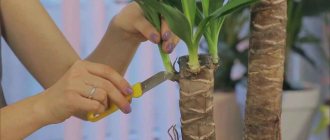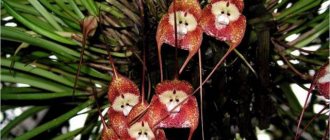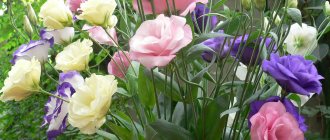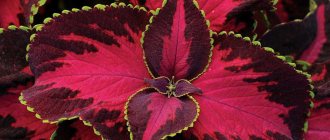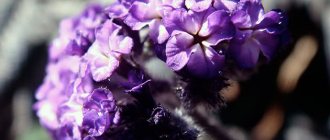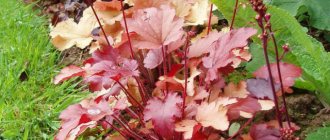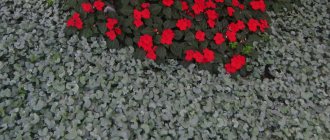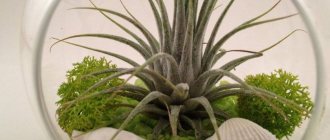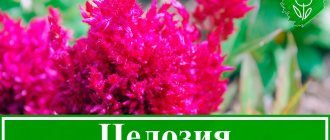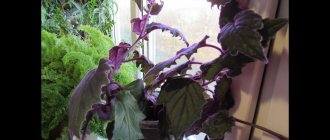Category: Care Published 02/25/2019 · Comments: · Reading time: 11 min · Views: 10,993
The yucca palm is a popular exotic plant that domestic gardeners successfully grow as a home flower. In fact, it is not a palm tree, it is a representative of another family, however, this does not deprive the yucca of its unusual beauty and similarity to tropical inhabitants. Is it difficult to care for this unusual green pet, in what conditions does it grow well and is it prone to diseases?
Features of Yucca
Yucca is an evergreen plant with a low stem that may have little or no branching. In some species it is impossible to discern the stem, while large, spectacular leaf plates rise immediately above the soil surface and are arranged in a spiral. Large erect inflorescences reach about 200 centimeters in length; they grow from the middle of a leaf rosette and have a panicle-like shape. The bell-shaped drooping flowers reach about 70 mm in length and are white in color. The fruit is a ten-centimeter capsule, inside of which there are black seeds, reaching up to 10 mm in diameter.
When growing at home, it is recommended to place the tree in a hallway or large room, because it can reach a height of about four meters. This plant looks very similar to a false palm tree. It should be borne in mind that flowering is observed only in adult yucca, during which white flowers appear that are similar in appearance to bells. Such a plant is often used as a decoration for a large room, and the most valuable are those bushes that have several growth points (branching trunk).
Useful properties of yucca
Yucca elephant indoors.
Photo Fibers from yucca, which grows naturally, are used for technical purposes to make denim fabrics durable. It is used as a dietary supplement in cosmetology. In folk medicine, healing and bactericidal properties are used.
Home plant species create coziness, a peaceful atmosphere, help purify the air and absorb noise. It is believed that peace and prosperity reign in a house where yucca grows. In office buildings, the mysterious flower is grown for good luck in business.
Brief description of cultivation
- Bloom . Yucca is grown at home as a large decorative foliage plant.
- Illumination . Needs bright light, which must be diffused.
- Temperature regime . In spring and summer, the plant feels comfortable at a temperature of 20 to 25 degrees; in autumn and winter, the room should not be warmer than 12 degrees.
- Watering . Immediately after the top layer of the substrate in the pot has dried to a depth of 50 mm, the plant is watered abundantly.
- Air humidity . Requirements for air humidity levels depend on the type of yucca. Some species require systematic moistening from a spray bottle, a regular warm shower, and it is also recommended to pour moistened expanded clay into the tray. However, some of the species grow at normal air humidity typical of living rooms.
- Fertilizers . In the spring-summer period, fertilizing is carried out once every 15–20 days; for this purpose, mineral complex fertilizer is used in half the dosage recommended by the manufacturer. The underside surface of the leaf plates is moistened with a nutrient solution.
- Rest period . Not clearly expressed.
- Transplant . It is carried out only if necessary after the root system becomes very crowded in the pot. This procedure is best carried out in the spring, but in the summer it is transplanted only if absolutely necessary. It is not recommended to replant very large bushes, but they need to be replaced every year with the top layer of substrate in the container.
- Soil mixture . The substrate must be neutral with a pH of 6.0–6.5. If possible, it is better to buy a ready-made soil mixture for yucca, and add 30 percent of sand (of the total volume) to it.
- Reproduction . By trunk sections, cuttings and seed method.
- Harmful insects . Whiteflies, spider mites, scale insects and mealybugs.
- Diseases . If the plant is not properly cared for or is not provided with suitable conditions for growth, then its foliage may lose its decorative effect.
Yucca in indoor conditions. All about growing.
Description of the plant
Yucca is indigenous to Central America and its arid regions. Visually, it is similar to a Palm tree, especially in its natural habitat, when the leaves from the lower tiers dry out and fall off, the trunk becomes lignified and only a bunch of hard leaves remains at the top. But this is not Palma.
There is some confusion regarding the classification of Yucca. At first, Yucca was classified as a member of the Liliaceae family, then to the Agave family, and now to the Asparagus family. Moreover, Yucca is now simultaneously on the list of representatives of both. In general, there is complete confusion. In addition to Palma, it is also often confused with other indoor flowers similar to Palma - Dracaena and Cordyline. An experienced florist will not be mistaken; he will immediately see the difference. But for beginners, this similarity is a little confusing.
Large specimen of Yucca
In nature, Yucca grows as a fully or partially leafy large shrub from two to eight meters in height. Indoor species grow up to a meter or two. Its tree-like stem is topped with green or gray dense leaves, sticking out in different directions or slightly drooping, pointed lanceolate or xiphoid in shape. The length of such a leaf can reach up to a meter, although indoor specimens have leaves no more than 50 cm in length. There are stemless species of Yucca, the crown of which consists of one or several rosettes.
Yucca blooms amazingly beautifully, throwing out powerful vertical peduncles, abundantly strewn with buds. Large flowers, up to 8 cm long, resemble cup-shaped bells. The flowers are most often white, but creamy-greenish, yellowish or pinkish tones are found in nature. The fruits are of no interest; they look like dry boxes. True, some species have juicy edible fruits. But unfortunately, not every gardener gets to see Yucca blooming at home. It grows quite quickly. From a small plant it can turn into a large bush or tree in a few years. What should be done to make the plant feel “at home” and at the same time maintain its compact decorative shape and dimensions acceptable for your room? Let's try to figure this out.
Caring for yucca at home
Illumination
When grown indoors, yucca should be provided with very bright lighting, as it is light-loving. However, despite this, the flower should be shaded from direct rays of the sun, especially if it is located near south-facing windows. It grows best on a western or eastern window. If natural light is too poor, then the bush must be illuminated for at least 16 hours a day with fluorescent lamps, for this they are installed at a distance of 0.3–0.6 m from the plant. In the warm season, if desired, the yucca can be moved outside, but you need to choose a place for it that will be protected from direct rays of the sun, as well as from rain. If in the summer it is in a room, then it should be systematically and quite often ventilated.
Temperature
In the spring-summer period, make sure that the room is no colder than 20 degrees and no warmer - 25 degrees. If the tree has been exposed to direct sunlight for a long time, then it needs to be moved to a shaded place, and after it has cooled, it should be moistened with a sprayer. In the autumn-winter period, the air temperature should not be higher than 12 degrees.
If during a warm winter the lighting in the room is too poor, then the bases of the stems may stretch, and the foliage will become thin, faded and lethargic. If the yucca weakens, it can cause an invasion of harmful insects, while its foliage turns yellow and flies off. If you cannot provide the plant with a temperature of 10 to 12 degrees in winter, then in the fall it is kept outside until the coldest weather, and in the spring it is transferred to fresh air as early as possible. If the bush is placed outside in a protected place, then even short-term frosts cannot harm it.
Watering
The frequency and abundance of watering the crop is influenced by the following factors:
- temperature and air humidity level;
- the size of the pot and the material from which it is made;
- bush size;
- substrate characteristics.
In the spring-summer period, watering should be plentiful; it is carried out immediately after the top layer of the soil mixture dries to a depth of about 50 mm. If the weather is hot in the summer, then watering should be more frequent, but still between them the surface of the soil mixture should have time to dry out. If the yucca is in a cool place, then the amount of watering is reduced, otherwise the liquid will stagnate in the soil mixture, causing rot to appear on the plant, and this can lead to its death.
Air humidity
Some types of yucca when grown at home must be systematically moistened with a sprayer. To do this, use boiled water at room temperature. To maintain high air humidity, you can pour moistened pebbles or gravel into the pan. When moistening the bush, it should be protected from direct rays of the sun, otherwise burns may form on its surface. In order to remove dust and dirt from the foliage, the bush can sometimes be washed under a warm shower, while the surface of the substrate must be protected from liquid ingress.
Fertilizer
In spring and summer, such a crop should be fed regularly once every 15–20 days. To do this, use a diluted mineral complex fertilizer. The plant responds well to feeding with infusion of mullein, leaf humus or horse manure. However, experienced gardeners recommend spraying the underside of the leaf plates with a solution of complex mineral fertilizer. If the plant is sick or it was recently transplanted, then you should stop feeding, since at this time they can only harm it.
Trimming
As a rule, yucca has only 1 trunk, but with proper pruning it can form several trunks. To do this, you will need a young bush, which must be healthy and strong, and its height must be at least 0.3 m. In the last spring or first summer weeks, cut off the top of the bush; for this you need to use a very sharp tool. You only need to cut off 50–100 mm, but so that as much foliage as possible remains on the bush. Be sure to treat the cut areas; to do this, sprinkle them with charcoal powder.
Yucca transplant
It is better to replant yucca in the spring, but this can also be done in the summer, if the need arises. Before planting, you need to make a good drainage layer at the bottom of the container; for this you use expanded clay, pebbles or broken bricks. The substrate should be average neutral with a pH of 6.0–6.5 if it contains peat. About 30 percent of sand (of the total volume of the substrate) should be added to the prepared soil mixture.
It is recommended to replant yucca using the transshipment method, while trying to keep the lump of earth intact. If rot appears on the root system, for example, due to stagnation of liquid in the substrate, then the plant must be replanted as soon as possible, and the rotten areas are cut out. Yucca is well suited for growing hydroponically.
Yucca home care / yucca plant
Features of transplantation
You should not replant a newly purchased yucca; you should give it some time to adapt. Then you can start transplanting:
- A tank with a volume slightly larger than the transport container is being prepared.
- The substrate needs to be fresh. To increase its looseness, you can add vermiculite or expanded clay - 1 part to 5.
- The bottom of the pot is covered with a 4-5 cm layer of drainage material, this can be expanded clay, crushed stone, fine gravel, pebbles or river pebbles.
- The plant is replanted using the least stressful method of transshipment - it is removed and transferred along with the old earthen lump.
- You cannot deepen the stem too much; if you do this more than 3 cm, the flower will rot.
- The remaining voids are filled with soil.
- There is no need to water the plant in the first 2-3 days.
At the end of the event, the flower must be watered and placed away from the rest of the vegetation. He will require special monitoring for 2 weeks. When the acclimatization time is over, the false palm can be placed in its designated place.
The plant is scheduled to be replanted depending on its age - young specimens annually, more mature ones - once every 3-4 years, partially replacing the soil with fresh one. The most suitable time for transplantation is spring; during this period it is easier for a green pet to adapt.
Yucca can grow profusely, and to prevent this, thus preserving its decorative properties, it is recommended to cut off part of the root system by ¼ during replanting. The sections are treated with activated carbon or charcoal powder.
It is not so easy to replant adult, large specimens, so it is easier to partially replace the soil once a year.
Reproduction methods
Growing from seeds
If desired, yucca can be grown from seeds. To do this, freshly harvested seeds are sown in a substrate consisting of turf and leaf soil, as well as sand, which are taken in equal parts. Crops should be systematically watered, ventilated, and condensation must be removed from the surface of the shelter. The first seedlings should appear after about one month. After the seedlings grow and become stronger, they will need to be planted into individual pots, reaching about 60 mm in diameter. Then they begin to gradually accustom them to the same care that an adult plant needs. After 12 months, the plants will need to be transferred to larger pots (20–30 mm larger in diameter than the previous ones).
Propagation by a piece of trunk
Since such a plant grows very strongly at home, it is propagated by a piece of the trunk, if there is such a need. In the summer, several parts need to be cut off from the trunk, and they should reach a length of more than 20 centimeters. The cuttings are planted for rooting in a slightly moistened soil mixture consisting of peat and sand, and the cut location should be at the bottom. Then the box is moved outside to a shaded place. On the parent bush, all cutting areas are covered with garden varnish. The planted sections must be covered with film on top; it will help maintain the required level of air humidity, while the air temperature should be from 20 to 24 degrees. Make sure that the soil mixture is slightly moist at all times. Rooting of the segments will occur after 4–8 weeks.
House plants. I root Yucca in two ways. Part 1.
Cuttings
To propagate such a plant, apical cuttings are also used. With a very sharp tool, cut off the top part of the plant, while the cut areas are treated with charcoal powder. The cuttings must be left in the open air for 2 hours so that the cut areas have time to dry. Then it is planted for rooting in moistened sand or placed in a container with boiled water. When rooting cuttings in water, a piece of charcoal is placed in a container; it should protect the cuttings from bacteria. Before the roots appear, rot may appear on the lower leaf blades. If this happens, then the leaves are removed and the water in the container is changed. After the roots grow, the cuttings are planted in a pot filled with soil mixture.
About diseases and pests of yucca
This false palm has very good health, however, errors in care can undermine it:
- Use cold, unsettled water for irrigation.
- Being in drafts.
- Excessive waterlogging and hypothermia of the soil.
- Damage to the root system.
Keeping the plant in cool and waterlogged soil often leads to rotting of the rhizome. The first symptoms of disturbances are lethargy and further loss of leaves. You can save your pet if you take emergency measures at the initial symptoms:
- remove the flower from the soil;
- inspect and trim rotten roots;
- the rhizome is treated with a disinfectant;
- A flower that has dried out in the open air is planted in fresh soil.
Specimens weakened by poor care, disease and unsuitable conditions are often attacked by parasites: mealybugs, aphids, spider mites, and scale insects. They can be removed using insecticidal preparations - Aktara, Karbofos. The plant is pre-treated with a solution consisting of shavings of laundry soap and water.
The owner of an exotic pet should be alarmed if the following signs are present:
- The tips of the foliage acquire a brownish tint - the flower suffers from a draft or too dry air. The soil may be dry and needs watering.
- The appearance of light spots is sunburn.
- Curling of the leaves - the yucca is frozen.
- The leaves become covered with brown spots with a yellowish border - a symptom of the fungal disease anthracnose. The main cause is high humidity, which can be treated with an antifungal agent.
- The formation of a whitish coating - perhaps the palm tree is suffering from powdery mildew. The disease is fungal and requires the use of fungicides.
To avoid trouble, it is recommended to take care of the plant by providing suitable conditions and care. Such preventive measures will maintain the health of your green pet.
Possible problems
- Yucca is turning yellow . If the lower leaf plates of yucca turn yellow, you should not be alarmed, as this is a natural process. The fact is that green leaf plates can only be at the top of the bush. The unusual appearance of such a plant is due precisely to the fact that it sheds its lower leaf plates.
- Leaves are falling . If some of the foliage has fallen off after the flower was purchased and brought home or after replanting, then this is a completely expected reaction to a change in usual conditions. If the foliage flies off en masse, this may be due to the plant being overcooled or due to the fact that it has been exposed to a draft.
- The tips of the leaves dry out and turn brown . Due to excessively low air humidity, the tips and edges of the leaf blades dry out and turn brown. This can also happen due to a draft or due to excessively infrequent or poor watering.
- Brown spots on leaves . If brown spots form on the plate, this indicates that the lump of earth in the pot has dried out.
- The leaves are curling . If the room is very cold, then the edges of the foliage turn brown, and the plates themselves curl. In especially delicate species, this can happen if it is cold at night and you forget to remove the flower from the windowsill.
- Spots on foliage . Sometimes, due to the scorching rays of the sun, dry, light-colored spots form on the surface of the leaf blades.
- Harmful insects . The most common pests that inhabit the plant are whiteflies, spider mites, scale insects and mealybugs.
Yucca varieties
The genus includes more than 3 dozen species, their main difference being the shape of the foliage and size. Some varieties have lanceolate leaves, others have pointed xiphoid leaves. The surface of the leaf plates can be smooth, covered with spikes or elongated hard fibers.
Breeders did not stand aside; thanks to their efforts, specimens with variegated, striped and even bright white foliage appeared.
Most often, elephant and aloe yucca are grown as a houseplant; a less common green pet is filamentous and glaucous yucca:
- Elephant
In old age, this yucca's stem base becomes thick and massive, making it look like an elephant's foot. It is unpretentious, but grows slower than other members of the genus.
- filamentous
In the southern regions of Russia, including Crimea, as well as in the Caucasus, filamentous yucca is grown in open ground and tolerates winter temperature drops well without additional shelter.
In central Russia, it is also grown outdoors, but requires shelter for the winter.
Filamentous yucca is stemless, grows in the form of a pretty bush with bluish-greenish, striped foliage.
Garden Yucca
- Aloe leaf
This false palm has dense, wedge-shaped leaves that are dark green in color. Young specimens look like a round bush, but with age they get rid of the lower leaves, turning almost into a palm tree.
Yucca aloe vera is found in abundance along coastlines from California to Mexico. They feel good on the sands of dunes and beaches covered with shell rock.
- Gray
Yucca with a shortened stem, even in nature does not grow above 2 meters. The foliage is beautiful, bluish-green, forming rosettes up to 90 cm in diameter.
This is interesting! Yucca looks very expressive in the interior, and in addition, it can be planted in the same tank with other indoor plants that do well in dry soils. An excellent companion flower would be geranium or kalanchoe.
The false palm tree will fit into the company of anthuriums, spathiphyllums, ficus Benjamin, zamioculcas and fatworts.
Types of yucca with photos and names
Yucca aloifolia
In nature, this species is found in Jamaica, Central America, Bermuda, and also in southern North America. The plant is characterized by extremely slow growth, but it can reach a height of about 8 meters. The tree-like stem of adult plants is highly branched. Rosettes of fibrous foliage form on the upper parts of the branches. The length of the lanceolate leaf blades is about 50 centimeters, they are dark green with a spike at the top and a serrated edge. In an adult bush, flowering is observed in the summer, at which time it forms a paniculate inflorescence, reaching half a meter in length. It grows from a rosette and includes many bell-shaped flowers, reaching 30 mm in diameter; they are painted a whitish-cream shade with a purple tint.
Yucca whipplei
In nature, this bushy, slow-growing plant is found in California, Mexico and Arizona. Its stem is short, and the hard and fibrous leaf plates are collected in rosettes, which reach about 100 cm in diameter. The leathery greenish-gray lanceolate foliage is about 100 cm long, has a thorn at the top and teeth along the edge. The inflorescence of this species is almost the same as that of Yucca aloelia, only it is longer (about 200 cm), and the flowers of the same color have a pleasant smell and are 5 mm larger. When flowering ends, the rosette dies, and many shoots form at the base of the plant.
Yucca beak-shaped (Yucca rostrata)
This tree, which has a thick trunk, can reach a height of about 300 cm, and its crown is highly branched. There are a large number of leathery, thin (width up to 10 mm) and long leaf plates that can be convex or flat. There is a sharp spike at the top of the plate, and small teeth grow on the yellow edge. The sheet itself is decorated with stripes. A panicle consisting of white flowers is formed on a long peduncle.
Yucca shortleaf (Yucca brevifolia)
Either tree yucca (Yucca arborescens) or giant yucca. In nature, the species can be found in southeastern California, and also in Arizona, mainly in dry parts. The height of the tree can reach up to 9 meters, and the diameter of its trunk reaches 50 centimeters. In the upper part the trunk is highly branched. Densely growing, hard and short foliage (length about 0.3 m) in the middle part reaches a width of about 15 mm, it has a groove on the surface, a spike at the top, and a fine-toothed edge. At the tip the leaf is colored brown. The short peduncle consists of yellowish flowers.
Yucca radiata (Yucca radiosa)
Or high yucca (Yucca elata). The height of such a tree is about 7 meters. It forms many densely spaced linear leaf plates, their length is about 0.6 meters, and at their widest point their width is only 10 mm. The plate narrows towards the base, its apex is pointed, and there are small grooves. The narrow white edges of the foliage are covered with a large number of thin threads. The length of the inflorescence is about 2 meters; at the top there are flowers collected in a panicle.
Yucca filamentosa
This plant is native to eastern North America. It has practically no stem. The root system goes into the deep layers of the soil. Such a plant can grow greatly due to root suckers. It can withstand short-term temperature drops down to minus 20 degrees. The leaf blades, pointed at the top, have a greenish-gray color; along the edges they are densely pubescent with thin curly white threads. The length of the foliage is about 0.7 m, and the width is up to 40 mm. To obtain viable seeds, the plant must be artificially pollinated. On a two-meter peduncle, many drooping eight-centimeter flowers of a yellowish-white color are formed. After flowering, a fruit is formed - a rounded capsule.
Yucca recurvifolia
The trunk of such a plant is short (about half a meter in height), in some cases it is highly branched. At its top, hard fibrous leaf plates are collected into a rosette. The greyish-green drooping foliage is leathery to the touch, lanceolate in shape and about 100 cm long, with a thorn at the top and a jagged edge.
Yucca glauca
This evergreen plant reaches a height of about 200 cm and is native to the western United States. Its stem is short. The meter-long rosettes consist of densely spaced, leathery, fibrous foliage. Lanceolate bluish-green leaf blades with a white edge reach a length of about 0.6 m. The edge can also be gray with flaking fibers. In adult plants in summer, a panicle-shaped inflorescence grows from a rosette, reaching a height of up to 100 cm. It consists of many bell-shaped flowers of a creamy white hue.
Yucca gloriosa
Native to the southeastern United States. In nature, the species is a spherical bush or a low tree (about 2 m). The tree-like stem can be weakly branched or single. Leathery to the touch, lanceolate bluish-green leaf plates reach up to 0.6 m in length; they have a sharp spine at the top and a sparsely toothed edge. In adult plants, in the summer, a panicle-shaped inflorescence grows from a rosette, reaching a height of about 250 cm. Many five-centimeter pendant flowers of a cream color with a purple tint are formed on it.
Yucca elephantipes
The fact is that this plant is similar in appearance to an elephant’s foot. Over time, it becomes a not very tall tree or an upright bush and has a height of about 10 meters. Its stem is tree-like and highly branched. At the tops of the branches there are leaf rosettes consisting of hard fibrous plates. Greenish, leathery to the touch, lanceolate leaf plates are 50–100 cm long, their edge is jagged, and there is a sharp thorn at the top. In summer, adult plants form an inflorescence about 100 cm long, which consists of many five-centimeter flowers.
Yucca treculeana
The species is native to Mexico and the southern United States. The weakly branching tree-like stem is characterized by slow growth; it can reach a height of about 5 meters. Leathery to the touch, bluish-green lanceolate leaf plates are collected in a dense rosette; they are straight or slightly curved, pointed at the top, their length is more than 100 cm, and their width is up to 7 centimeters. In summer, in adult bushes, an inflorescence about 100 cm long appears from a rosette; it consists of many hanging bell-shaped flowers, white with a purple tint.
Yucca Schottii
Or large-fruited yucca (Yucca macrocarpa). The species grows on sandy soil in southern Arizona. The weakly branching or straight trunk reaches a height of about 4 meters. The hard, light-gray straight leaf blades are about 50 cm long and up to 4 cm wide. The plate tapers slightly at the base, and its edge is covered with thin threads. The branches and peduncle are bent, and the loose inflorescence has a panicle-like shape.
Southern Yucca (Yucca australis)
Or filamentous yucca (Yucca filifera). The height of the tree is about 10 meters, its upper part is highly branched. The densely growing dark green leaf blades, leathery to the touch, are about 30 centimeters long and up to 3 centimeters wide, their edges are covered with threads. During flowering, a branched, hanging inflorescence two meters long is formed, which consists of a large number of cream-colored flowers.
YUCCA! Pruning, cuttings, planting in a capsule of ceoflora!
Yucca propagation
For propagation, you can use plants that have grown greatly or have lost their shape, vegetative parts obtained from pruning, and lateral shoots.
Yucca propagation by dividing the trunk
The method is suitable for owners of adult yucca, which it is time to rejuvenate. The upper part of the trunk is cut into pieces 18-20 cm long with dormant buds. If the plant is not tall, only the top is cut off, from which a new yucca will emerge.
A cut of an adult plant is treated with garden varnish. The pot is left in the shade and watering is reduced. Soon the trunk will sprout young shoots. Cut parts of the trunk are used for engraftment:
- The cuttings are set aside for 20-30 minutes to dry.
- Place the cutting in moist soil and press it against the trunk.
- Cover the container with film to maintain the microclimate and humidity.
- The greenhouse is constantly ventilated and condensation is removed in a timely manner.
- After the sprouts and roots appear, each young shoot is cut off and planted in a separate container.
Advice! The cuttings can be germinated in boiled water with the addition of activated carbon tablets to prevent the development of putrefactive processes.
Yucca propagation by lateral shoots
This method is suitable when there are lateral shoots and they thicken the stem. Excess shoots are cut off with a sharp knife, and the sections are treated with charcoal. For engraftment, the prepared fragments are planted in suitable soil and a mini-greenhouse is organized. Soil and air humidity should be moderate so that putrefactive processes do not develop.
If there are no lateral shoots, you can artificially create conditions for their germination. To do this, an incision is made on the trunk below the attachment point of the bottom leaf, and the bark is removed in a strip of about one and a half centimeters along the entire circumference. Place damp moss at the cutting site, then a layer of plastic film to retain moisture and wait for the dormant roots to awaken. If the procedure is successful, you can get healthy cuttings, which are subsequently cut and planted in the ground.
Pruning and crown formation
To improve the appearance of the yucca, make it more lush, branch into 2-3 trunks, trim the top. The work must be done with care so as not to harm the plant:
- The best time for pruning is the end of February - beginning of March.
- 2 days before planting, water the yucca.
- Considering that the cut yucca stem will not grow after this, the procedure is carried out when it reaches a thickness of at least 5 cm and a sufficient height.
- You will need a disinfected sharp knife or pruning shears.
- With one hand they hold the leaves and stem, with the other they cut off the top of the head in one movement so that you don’t have to break it.
- The cut areas are disinfected with alcohol and dried for 2 hours in fresh air, and then sprinkled with crushed activated carbon.
Below the cut site, dormant buds should begin to grow in 3-4 weeks. The thicker the mother trunk, the more new shoots can be left (from 2 to 4).
The trimmed top of yucca is used for propagation.
Old, dried, damaged leaves also need to be removed. It is advisable to plan the event for the spring, but the beginning of the active growing season. Instruments are pre-disinfected with an alcohol solution.
Why do yucca leaves turn yellow and dry and what to do about it?
Noticeable yellowing of the leaves, which turns white, is combined with stretching upward - there is a strong lack of lighting. If there is little natural light source, then you need to place fluorescent lamps nearby. Have the leaves turned yellow and drooped at the base of the yucca? This means that the plant is over-hydrated.
Drying of the leaves is associated with scale insects or excessive dryness in a hot room. Interior decorating is great. By putting your soul into growing unpretentious exotic yucca, you can turn any room into a paradise.
X
Description of Yucca
Yucca is a plant with a low stem that avoids branching. In some species of Yucca, the stem is hidden from view, so you might think that the leaves rise straight from the soil.
The huge inflorescences that appear from the middle of the leaf rosette are slightly more than two hundred centimeters in length.
But the light bell-shaped flowers grow no more than seventy mm in length.
The fruit of the yucca is expressed in a ten-cm capsule, which has dark ten-millimeter seeds.
Lighting
Yucca loves good lighting . Its leaves are covered with a thin layer of waxy coating; they are dense, tough and perfectly adapted to all kinds of living conditions. Therefore, she is not afraid of even the brightest sunlight. In summer it can withstand even the brightest sun provided there is good aeration, i.e. sufficient supply of fresh air.
In winter, lighting depends on temperature .
Temperature
In summer, the air temperature can be almost any : yucca tolerates temperatures above 30, especially in the fresh air or in a well-ventilated area.
Rest period
In winter, yucca needs coolness for at least 2 months. This is not a slight drop in temperature, but rather cool conditions, +5 - +8°C.
With such maintenance, lighting does not play - the plant is at rest and does not grow .
This period is very important for development - flower buds are laid. With such content, additional lighting may not be necessary.
If it is not possible to arrange a cool winter, then it is necessary to provide the plant with as much natural and artificial light as possible, otherwise it will stretch, bend the trunk and fade.
When grown in the garden, yucca sometimes requires shelter for the winter. The yucca is wrapped in several layers of thick paper or cardboard, the packaging is secured, and the ground around is mulched with sawdust, straw, or insulated with spruce branches.
In areas where the winter temperature drops below -10°C , it is advisable to grow yucca year-round in a pot, taking it outside during the warm season.
Air humidity
Yucca tolerates dry indoor air, but atmospheric moisture has a positive effect on its appearance and well-being, especially at high temperatures.
Watering
In the warm season, with active growth, you need to water abundantly , but not often. Moisten the soil for yucca in a pot only after the earthen clod has completely dried out.
IMPORTANT! When water stagnates, fungi and algae very quickly settle in the soil, to which yucca is sensitive.
during the dormant period is even more dangerous . At this time, there is a high risk of root rotting. In the cool winter, yucca is watered very rarely and very little at a time so that the roots do not dry out. This is exactly the case when it is better to underfill than overfill.
How to care for pseudo-palm yucca?
Now let’s take the advice on how to care for the yucca palm into practical terms and look at the example of growing the most common species - Yucca ivory.
Landing
Let's start with planting material. This can be a rooted yucca cutting or a finished plant purchased at a garden center - in this case, planting means transferring it from a shipping container to a permanent pot.
You can buy ready-made substrate for planting - choose mixtures intended for palm trees, dracaena, and yucca. If you decide to make it yourself, you will need the following components (the number of parts is indicated in parentheses):
- turf land (1);
- rotted leaf or pine litter (1);
- coarse river sand (1.5);
- humus (0.5).
Leaf soil can be replaced or combined with peat; instead of humus, use vegetable compost or purchased vermicompost.
For adult pseudo-palms, the soil needs a more dense soil, at least half of which is turf soil.
Take a deep pot for planting, and drainage must be placed at the bottom. The size is determined so that the root ball enters freely, and there is a gap of 1–1.5 cm along the edge.
If you have any questions, we have a separate article on planting yucca; additional information can also be found in the video on the topic.
Watering
To prevent soil acidification, it is recommended to use filtered or at least settled water for irrigation.
You can also soften it with peat. To do this, 100 g of peat crumbs are placed in a fabric bag and dipped in a container with 10 liters of water, soaked for a day. It is also a light mineral-organic fertilizer.
What determines the frequency of watering?
- From the size of the plant. Adult large specimens are watered less often than small ones.
- From the volume of soil. In a 5-liter pot, the soil will dry out faster than in a 15–20-liter pot.
- Depending on the time of year. In summer, the palm tree grows actively, consumes more moisture, in winter it goes into suspended animation and hardly drinks.
- From the temperature in the room. The hotter it is, the faster the earth dries out. This also applies to winter, if it is not possible to lower the temperature to 10–14° C.
- From air humidity. In a dry room, water more often.
Read more about water consumption rates, the signals that the plant gives when there is a lack of moisture or waterlogging, and other aspects of watering yucca here.
Top dressing
Yucca is considered an unpretentious plant, accustomed to the spartan conditions of semi-deserts. But in nature, it compensates for the lack of nutrition by colonizing large volumes of open ground. The amount of soil in a pot is limited, so you can’t do without fertilizing.
The palm tree needs an enhanced diet during vegetation growth, i.e. from approximately March to August, the frequency of feeding is once every 2-3 weeks.
How can you feed indoor yucca?
- Liquid mineral fertilizers such as “Master”, “Activin”, “Flower Paradise”. Choose complexes specially designed for palms, yuccas, and dracaenas.
- Targeted organomineral complexes based on humic acids with the addition of microelements (“Umbrella”, “Gumisol-M”, “Absolut”).
- Any complex fertilizers intended for feeding decorative deciduous indoor plants. But in this case, we make the solution 2–3 times weaker than recommended by the manufacturer.
- A weak solution of organic matter, for example, granulated horse manure (“Orgavit”).
In addition to root feeding, foliar feeding is practiced - spraying leaves from the back side. They can be alternated.
Fertilizing is contraindicated in winter, when plants are resting, immediately after transplantation, during illness or pest damage.
Trimming
To get not an elongated trunk with a bunch of leaves on the top, but an interesting multi-level shape, it is recommended to prune the yucca.
They begin to form the plant when it rises by 60–70 cm, and the stem in diameter exceeds 5 cm. The most suitable time is spring. Before a traumatic procedure, water the plant generously.
During the first pruning, the top is removed, leaving a stump 40–50 cm high. The wound at the cut site is dried and covered with garden pitch, as an alternative - crushed activated carbon, wood ash, melted paraffin.
Pruning stimulates the awakening of axillary buds, of which from 1 to 5 can awaken at the same time. Leave those that will form the second-order trunks you need. The excess can be cut off and rooted.
How many sprouts to leave depends on the thickness of the trunk. If it is plump (6 cm or more), it will withstand and bear 3-4 shoots normally. For thin (less than 5 cm) – two are enough.
The following pruning is carried out to obtain branching of the trunks of the second order. You need to trim them one by one (one at a time), waiting until the sprouts appear and develop.
If you cut several stems at the same time, it will be difficult for the tree to grow so many shoots at once. In addition, pruning at different levels allows you to cover the bare parts, the yucca looks more picturesque.
Looking at the luxurious trees, as in the photo below, you can’t help but wonder how quickly yucca grows, and how long it will take to get such a beauty. We'll have to be patient. Usually, with proper care, the plant adds 10–15 cm per year.
Transfer
Yucca transplantation at home can be:
- primary – from transport soil to permanent soil;
- planned (regular) – once every 2–3 years;
- emergency (extraordinary) – for diseases of the root system.
Let's consider when and why a planned plant transplant is needed.
Determining that a yucca has outgrown an old pot is quite simple.
- The plant loses stability and collapses under its own weight.
- The roots completely entwined the soil and exit through the drainage hole.
- Water absorption became worse.
- New leaves grow more slowly than usual.
Plan to replant your houseplant in the spring. Prepare in advance a fresh substrate (the composition is the same as for planting), drainage, and a larger pot.
Before an important event, do not water the plant for several days, especially if the soil is depleted and needs to be removed as much as possible. If the soil is good, transshipment will be less painful - just remove a third of the old substrate in the upper part of the earthen clod.
Before placing your palm in a new pot, carefully inspect the roots. They should be light and elastic. Cut the blackened, softened pieces to living tissue, rub the sections with wood ash.
It is not recommended to replant the Yu. ivory flower often. A cramped pot is useful for her, since in this case the leaves grow slowly, naturally age, dry out, and form a trunk. A large volume of soil, on the contrary, stimulates the development of roots, the growth of green mass, and the trunk is formed worse.
You can learn about other aspects and subtleties of plant transplantation in a detailed article devoted to this topic.
Bloom
Flowers are the only thing you can't expect from a yucca kept in captivity. The fact is that in order to lay a flower bud, you need to endure a dormant period (November–February) with a temperature in the range of 10–14 ° C and at least 12–14 hours of daylight. In addition, only an adult plant blooms (from 7–10 years).
Try to bring the conditions closer to the natural environment, then the release of the peduncle will be quite real.
Yucca diseases
A palm tree that receives good care rarely gets sick. Only if handled incorrectly can a bacterial burn or rotting of the trunk or leaves occur. Sometimes the plant turns yellow, but this may be a natural process of development and growth of the palm tree, during which it gets rid of excess leaves. If yellow elliptical spots appear on the flower, which gradually become brown, this indicates the presence of brown spotting.
In winter, the death of a flower is often caused by excessive watering or very low temperatures. As a result of the huge amount of moisture, pests can appear on the flower: thrips, scale insects, spider mites, aphids or caterpillars. If the plant is already affected, you need to remove the cause of the weakening and treat the flower with insecticides, strictly following the instructions. Owners of evergreen beauty often have questions about how to combat various diseases, but before treatment you should study all existing yucca diseases:
- Rot caused by Fusarium fungi. During the disease, the crown is affected, the leaves are susceptible to rot. At the initial stage of the disease, you need to remove the diseased parts of the tree and spray with a fungicide solution.
- Cercospora blight. Oval brown spots appear on the surface of the leaves. With high humidity, the disease can progress. To eliminate the disease, you should reduce watering, do not spray for several days, remove infected stems, and treat the palm tree with a fungicide. Mineral fertilizers should be used for feeding.
- White rot of yucca. The leaves of the plant that are close to the ground are most damaged by this disease. When affected, they become discolored and watery. To get rid of the disease, remove the affected tissue and treat with systemic fungicides (Fundazol, Rovral).
Reproduction
Gardeners propagate yucca in four ways.
Seeds
The main thing here is to choose the right seeds for planting. You can collect them at home only after pollination. Stages:
- File the seeds with sandpaper so that the hard shell is damaged, so they will sprout faster.
- Soak them in water for a day.
- Plant in a small container with a special earthen mixture.
- Cover with film and place in a warm place in the house with good lighting, constantly moisten the soil.
- Wipe the film every day to remove condensation.
- As soon as shoots and leaves appear (in about a month), plant the plants in different containers and feed them with fertilizers on the 10th day.
- After the germination of 5 leaves, the plant is considered mature.
Cuttings
- Make a smooth cut from an adult plant.
- Dry and treat with growth agent.
- For soil, use a mixture of peat and river sand.
- Transfer the cutting to the ground and bury it 3-4 cm in the soil.
- Water the soil well and spray the shoot itself daily.
Parts of the trunk
This way you can propagate an adult plant, but only in the spring. Process:
- Carefully cut off the top of the bush and dry.
- Place the cuttings in water until they form the first roots, then into the soil.
- As soon as the buds produce young shoots, plant them.
Adventitious roots
Used for stemless yucca species. In summer or spring, the root shoots are cut off with a knife, and the seedlings are transplanted into a pot with wet sand.
Trimming
The palm tree is pruned in order to rejuvenate the plant and give it a beautiful shape. If the yucca is strongly stretched upward, pruning is also carried out.
The procedure is best carried out in the spring, when the plant stops growing. Before trimming indoor yucca, tools must be disinfected with alcohol. The cut should be completed to the end, and not break off branches with leaves, so as not to touch the growth points. The cut areas must be treated with crushed coal to prevent the process of rotting. After the operation, the plant is returned to its usual habitat and watered according to existing climate conditions. The cut parts of the plant are not thrown away, but are used for propagation.
Video “Yucca propagation”
When and how does it bloom
Pereskia flower - home care
How indoor yucca blooms: domesticated specimens almost never delight their owners with flowers. To obtain buds, it is necessary to create special conditions and special care, which can only be performed by experienced gardeners.
Important! Despite these features, with the right approach, small sprouts quickly grow into luxurious trees and bushes.
Flowering plant
Yucca and family environment
Experts unanimously say that yucca can be kept in almost any family, its leaves are not poisonous and do not cause allergies, however, it is still not recommended to keep it in the bedroom.
The plant requires moderate humidity and constant temperature, and this will benefit the other inhabitants of the apartment. You will never forget to maintain a healthy microclimate in the apartment, and if it ceases to be healthy, the palm tree will tell you about it with its appearance so that you can take action in time.
Now you know how a house plant is - yucca is simply a godsend. Keeping it at home is a pleasure, in addition to all the advantages described in the article, such as unpretentiousness, minimal required care, it also looks very beautiful and impressive and is part of the interior of the apartment.
Esoteric specialists recommend keeping it in places where strangers are, because they believe that the plant will help protect apartment owners from the evil eye and negative emotions.
